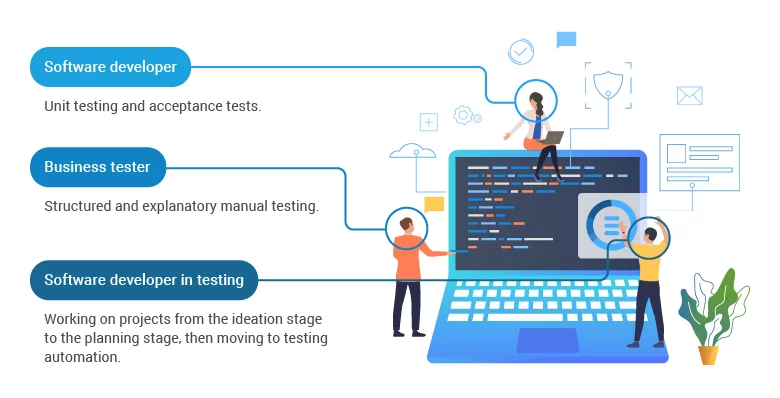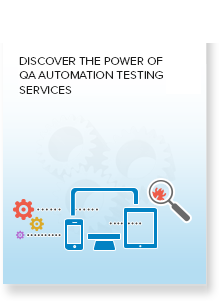Measuring ROI in QA automation for business excellence

In the fiercely competitive world of software development, maintaining a competitive edge requires more than QA automation—it needs a meticulous assessment of its true impact and return on investment (ROI). By using data-driven insights and diligently monitoring key metrics, businesses can tap into the full power of QA automation, optimize their software development processes and propel themselves toward unparalleled success. Prepare to embark on a journey that will reshape your software development approach. This blog will delve into the realm of ROI analysis and discover the transformative capabilities of QA automation testing services.
Did you know?
69% of day-to-day managerial work will be entirely automated by 2024. – Gartner
Beyond the financial gains, ROI in QA automation encompasses a broader perspective that extends to cost savings, amplified efficiency, enhanced software quality and improved customer satisfaction. It is a testament to the transformative power of leveraging data-driven insights and making informed decisions. The journey toward ROI excellence in QA automation is an ongoing process that requires continuous evaluation, refinement and adaptation to the ever-evolving software landscape. By embracing this journey, you position your organization at the forefront of software development, equipped with the tools and knowledge to drive unparalleled success.
Key metrics for measuring ROI in QA automation:
Metric #1 Test execution time: By automating repetitive and time-consuming test cases, organizations can drastically reduce test execution time. This translates into substantial cost savings and faster time-to-market. The ability to track and analyze test execution time empowers businesses to identify bottlenecks, optimize testing efforts and achieve unparalleled efficiency gains.
Metric #2 Defect detection and prevention: QA automation testing services plays a pivotal role in identifying and mitigating defects early in the software development cycle. Measuring the number of defects caught and prevented through automation showcases the value of automation. It also ensures higher software quality, customer satisfaction and significant cost savings in the long run.
Metric #3 Test coverage: Measuring test coverage is a critical aspect of assessing QA automation effectiveness. Comprehensive test coverage leads to improved software quality and reduced risk by encompassing a wide range of scenarios and functionalities. The ability to monitor test coverage metrics enables organizations to identify gaps, prioritize testing efforts and ensure comprehensive software testing.
Metric #4 Resource utilization: One of the most significant benefits of QA automation testing services is resource utilization. By automating repetitive and mundane tasks, testers can focus their expertise on more critical aspects of testing, such as exploratory testing and test strategy development. Tracking resource utilization and the resulting cost savings not only showcases the tangible benefits of automation but also enables organizations to allocate resources strategically.
Metric #5 Regression testing efficiency: Automation simplifies regression testing, which ensures the stability of software solutions. The efficiency of regression testing can be measured in terms of time and cost savings achieved through automation. Organizations can accelerate time-to-market and foster continuous improvement by minimizing regression testing efforts.

Continuous test automation services and different practitioners
In the realm of software development and quality assurance, the concept of continuous testing has gained significant traction in recent years. Continuous testing refers to the practice of integrating testing activities seamlessly into the software development lifecycle, ensuring early detection of defects and rapid feedback to the development team. One aspect that plays a crucial role in the success of continuous testing is the collaboration and involvement of different practitioners and the QA automation services within the software development ecosystem.
Let’s explore how continuous test automation aligns with the roles of various practitioners and enhances the overall testing process.
Best practices for QA testing and measuring ROI
1. Effective tracking and analysis: Implement robust tracking mechanisms to capture accurate and relevant data. Leverage automation tools and reporting systems to generate comprehensive insights that highlight the impact of QA automation testing services. Visualize data in intuitive dashboards that provide actionable insights for decision-making.
2. Establish baseline measurements: Assess the current state of QA automation by establishing baseline measurements. These benchmarks serve as reference points for tracking progress and evaluating the effectiveness of automation strategies. Regularly review and update these measurements to ensure they align with evolving business needs.
3. Continuous improvement: Foster a culture of continuous improvement by analyzing metrics, identifying areas for enhancement and implementing strategic changes. Embrace a mindset of agility and adaptability to keep pace with the ever-evolving software landscape. Regularly evaluate and refine QA automation strategies to meet the dynamic demands of the industry.
Improving the return on investment (ROI) for QA automation involves implementing strategies and practices that maximize the benefits and effectiveness of automation. Here are some ideas to consider for improving ROI in QA automation:
- Test case prioritization: Focus on prioritizing test cases based on criticality and risk factors. By identifying and automating the most critical test cases, you can ensure that valuable resources are allocated effectively and provide quicker feedback on critical functionalities.
- Continuous integration and delivery: Implement continuous integration and delivery (CI/CD) practices to streamline the software development and testing processes. By automating the build and deployment processes, you can reduce manual effort, minimize errors and accelerate software updates delivery.
- Test data management: Develop effective strategies for managing test data sets so they can be created and maintained efficiently. By automating the generation and provisioning of test data, you can enhance test coverage, reduce test setup time and increase testing efficiency.
- Test environment management: Optimize test environment management by automating environment setup, configuration and teardown processes. This ensures that testers have access to the required environments promptly, minimizing waiting time and maximizing productivity.
- Continuous Monitoring: Implement continuous monitoring of test automation services and infrastructure to detect and resolve issues proactively. This helps in minimizing downtime, ensuring the stability of the automation framework and maximizing the efficiency of test execution.
By implementing these ideas and continuously evaluating and optimizing your QA automation processes, you can improve the ROI and achieve additional benefits from your automation investments. Remember that ROI improvement is an ongoing effort and requires a combination of strategic planning, technical excellence and continuous improvement practices.

Discover The Power of QA Automation Testing Services
Assurance testing. Before the application is made public or sent to the client, it needs to have addressed every issue and bug that might have crept in during the coding of the application. Delegating a dedicated engineer to perform manual tests can get cumbersome.
ROI redefined: Empowering businesses with QA automation excellence
Measuring ROI in QA automation is no longer a luxury—it is imperative for organizations striving for excellence. By embracing data-driven insights and tracking key metrics, businesses can propel their software development processes to new heights, delivering exceptional quality and achieving unparalleled success.
The power of QA automation lies not only in its ability to save costs and enhance efficiency but also in its potential to revolutionize software development, testing and delivery. Through reduced test execution time, robust defect detection and prevention, comprehensive test coverage, optimized resource utilization and streamlined regression testing efficiency, organizations can achieve remarkable outcomes and ensure their competitive edge in the market.
To make the most of QA automation and measure its ROI effectively, it is essential to implement best practices. Establishing effective tracking and analysis mechanisms, leveraging automation tools and visualizing data through intuitive dashboards are key to extracting actionable insights.
With Softweb Solutions, it’s possible. Furthermore, setting baseline measurements, regularly reviewing progress and embracing a culture of continuous improvement enable companies to stay ahead of the curve. This allows them to adapt to the ever-changing software landscape. If you would like to build something along the lines, you can get in touch with us and we’ll come up with a fruitful solution for you.
Originally content published at www.softwebsolutions.com
Post Your Ad Here
Comments